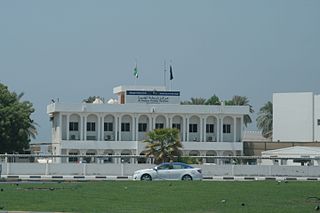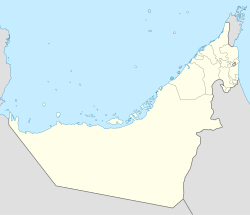
Ajman is the capital of the emirate of Ajman in the United Arab Emirates. It is the fifth-largest city in UAE after Dubai, Abu Dhabi, Sharjah and Al Ain. Located along the Persian Gulf, it is engulfed by the larger emirate of Sharjah in territory.

The Al Nuaimi family is the ruling royal family of Ajman, one of the seven emirates that together comprise the United Arab Emirates (UAE).
Masfout is a village that forms part of the eponymous exclave of Masfout in Ajman, one of the seven emirates forming the United Arab Emirates. It is surrounded by Ras Al Khaimah, the Dubai exclave of Hatta and Oman. It is only accessible from Ajman itself by crossing territories of Sharjah, Ras Al Khaimah, and Oman.

Al Heera is a suburb in Northern Sharjah in the United Arab Emirates, traditionally home to the Al Bu Shamis section of the Na'im tribe. At one stage declaring its independence from Sharjah, with its own Sheikh, it formally became part of the Emirate of Sharjah in 1942 on the death of its Ruler, Abdulrahman bin Muhammad Al Shamsi. A coastal settlement with a small harbour formerly used by a number of fishermen and pleasure boat owners, its main distinguishing feature today is its police station, converted in 2019 into the 'Al Heera Literature Society' building.
Sheikh Maktoum bin Hasher Al Maktoum was the Ruler of Dubai from April 1894–February 1906. The fifth Maktoum Ruler since the establishment of the dynasty in 1833. Maktoum's short but 'liberal and enlightened' reign was to transform the coastal port. He was responsible for the establishment of the trading community of Dubai, encouraging disaffected merchants from Lingeh to bring their businesses to Dubai after the Persian government had introduced unpopular taxes.
Sheikh Salim bin Sultan Al Qasimi was Ruler of Sharjah, a Trucial State and now one of the United Arab Emirates, from 1868–1883. His rule was unusually tumultuous and marked by intrigue, the secession of Sharjah's dependencies and constant conflict. He was also briefly the Ruler of Ras Al Khaimah from 1868–1869 and its wali, or governor, from 1908–1919.
Sheikh Khalid bin Ahmad Al Qasimi was the Ruler of Sharjah, a Trucial State and now one of the United Arab Emirates, from 1914–1924 and Ras Al Khaimah from 1914–1921. He acceded on the death of Saqr bin Khalid Al Qasimi. His rule was tumultuous and unpopular, marked by internecine conflicts and public discontent and saw the final disintegration of the Al Qasimi's joint rule over Sharjah and Ras Al Khaimah. Deposed as Ruler of Sharjah in 1924, he went on to become ruler of Dhaid and Kalba and a highly influential figure in the Shamaliyah.

Sheikh Sultan II bin Saqr Al Qasimi was the Ruler of Sharjah, a Trucial State and now one of the United Arab Emirates, from 1924 to 1951. His father having ceded the rule of Sharjah to Khalid bin Ahmad Al Qasimi, Sultan found himself dispossessed and married the daughter of Abdulrahman bin Shamsi, the headman of Al Heera. Buoyed by Khalid's unpopularity and Abdulrahman's force of personality and arms, Sultan deposed Khalid and became Ruler of Sharjah. However, he found the interior of the country dominated by Bedouin tribes and the East coast increasingly dominated by the former Ruler, Khalid bin Ahmad, leaving Sultan the effective ruler of a cluster of coastal settlements, many of which constantly tried to secede from his rule. He is cited as having presided over a low ebb in the power of the Al Qasimi, formerly a powerful maritime federation.
Sheikh Hamad bin Ibrahim Al Mualla was Ruler of Umm Al Quwain from 1923 to 1929, one of the Trucial States which today forms part of the United Arab Emirates (UAE).
Sheikh Rashid bin Humaid Al Nuaimi was the Ruler of Ajman, one of the Trucial States which today form the United Arab Emirates (UAE), from 1816–1838, leading a force of 50 men to take control of the town from members of the Al Bu Shamis tribe who had settled there and also at Al Heera. At the time, Ajman was a dependency of Sharjah. Five years after his establishment at Ajman, the fort was taken by the Darawisha Bedouin who were removed by the action of the Ruler of Sharjah, Sheikh Saqr bin Sultan Al Qasimi.
The Bani Qitab is an Arab tribe of the United Arab Emirates (UAE) and Oman. The singular form of the name, Al Ketbi, is a common family name in the Northern UAE today. Consisting of a settled southern section and a nomadic northern section, the tribe was long influential in the conduct of affairs in the interior of the Trucial States. The Northern branch mostly settled in the inland towns of Dhaid and Al Falayah.
The Na'im is an Arab tribe in the United Arab Emirates. The tribe is also present in other gulf countries.
Humaid bin Rashid Al Nuaimi was the Ruler of Ajman, one of the Trucial States which today form the United Arab Emirates (UAE), from 1838 to 1841, when he was deposed by his brother, Abdelaziz bin Rashid Al Nuaimi. Humaid ruled from Abdelaziz' death in 1848 until his own death in 1864.
Abdelaziz bin Rashid Al Nuaimi was the Ruler of Ajman, one of the Trucial States which now form the United Arab Emirates (UAE), from 1841 to 1848.
Abdulaziz bin Humaid Al Nuaimi was Ruler of Ajman, one of the Trucial States, which today form the United Arab Emirates (UAE), from 1900 to 1910. He steered Ajman through a period in which tribal conflicts triggered instability throughout the coast but was to ultimately meet the fate he had himself engineered for his predecessor.
Humaid bin Abdulaziz Al Nuaimi was Ruler of Ajman, one of the Trucial States which today form the United Arab Emirates (UAE), from 1910–1928. His rule was marked by a running conflict with the Al Bu Shamis and their charismatic Sheikh, Abdulrahman bin Muhammad Al Shamsi.

Sheikh Mohammed bin Hamad Al Sharqi was an Emirati royal, politician and a founder of the United Arab Emirates who served as the ruler of Fujairah from 1938–1974. In 1952 he was to see his father's long-held dream of independence for Fujairah recognised by the British, the last Trucial State to be so recognised, as well as shortly afterwards to help take the UAE to independence as a nation, in 1971. Due to his skills in diplomacy and politics he was called the wolf of the Gulf.
Sheikh Khalifa bin Shakhbut Al Nahyan was the Ruler of Abu Dhabi, one of the Trucial States which today form the United Arab Emirates (UAE), from 1833 to 1845. His bloody accession led to the secession of the Al Bu Falasah and the establishment of the Maktoum dynasty in Dubai.
Abdulrahman bin Muhammad Al Shamsi was the Sheikh, or head man, of the township of Al Heera, today a suburb of Sharjah in the United Arab Emirates. A highly influential and often divisive figure in regional politics during the early 20th century in the Trucial States, he was referred to by one British Political Resident as ‘a stormy petrel of the Trucial Coast, a man feared by everyone in and around Sharjah’.

The Al Bu Kharaiban is an Arab tribe of the United Arab Emirates, a subsection of the Na'im and the tribe from which the Rulers of the Emirate of Ajman are drawn.









